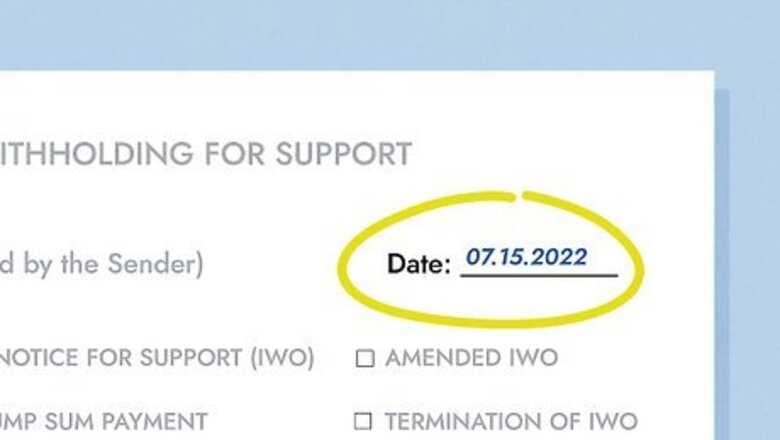
views
Processing an Income Withholding for Support Order/Notice
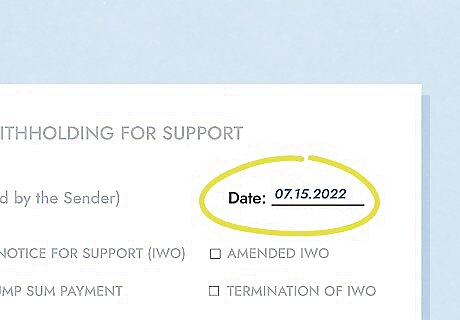
Document the date you receive the form. If you, as an employer, receive an income-withholding order ("IWO") in the mail, the first step you should take is to record the date you received the form somewhere in your company records. This is important because this date will be important in determining when you must begin withholding part of the employee's income in accordance with state law. For example, in California, you must begin withholding no later than the first pay period occurring 10 days after receiving the IWO. In Ohio and Indiana, you must begin withholding no later than 14 business days after the mailing date of the IWO. The federal Office of Management and Budget ("OMB") approved a standard form, known as an IWO, for use in income withholding for child support. This is the form you will receive.
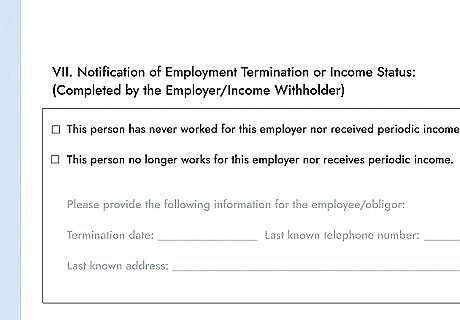
Determine if your company currently employs the individual listed on the IWO. In order to withhold a portion of a person's wages for child support, you must currently be paying that person a wage. Once you receive the IWO, check to see if the person listed on the first page of the form is a current employee of your company. If the individual has (1) never worked at your company or (2) no longer works at your company, you must complete the section entitled "Notification of Employment Termination or Income Status" on the fourth page of the IWO. You will then need to notify the sender of the IWO by returning the completed IWO to their contact address, which should be listed on the bottom of the fourth page.
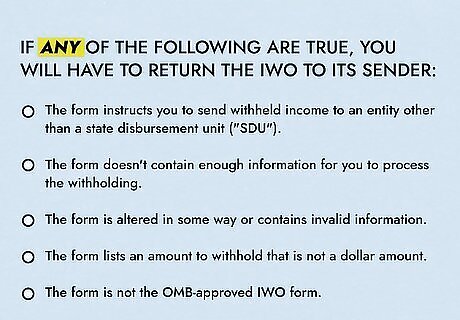
Check to see if the IWO is "regular on its face." The law requires every IWO to be completed according to a strict set of guidelines and contain certain required information. If the IWO is incorrect or incomplete in some way, then the IWO is not considered "regular on its face." You will have to return it to its sender so it can be corrected. If any of the following are true, you will have to return the IWO to its sender: The form instructs you to send withheld income to an entity other than a state disbursement unit ("SDU"). Each state has an SDU, which is the government agency that collects withheld income for child support and distributes that income to the person responsible for the child's care. The form doesn't contain enough information for you to process the withholding. The form is altered in some way or contains invalid information. The form lists an amount to withhold that is not a dollar amount. The form is not the OMB-approved IWO form. If you believe the IWO is not "regular on its face," you must check the "Return to Sender" box on the second page of the IWO and return the form to its sender.
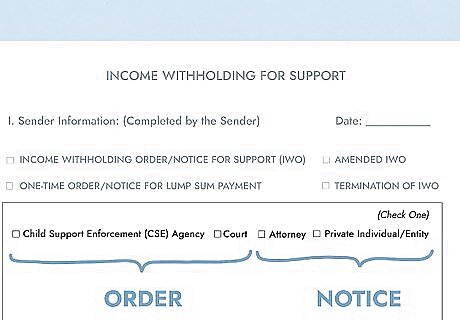
Determine if the IWO is an "Order" or a "Notice." You will do this by looking at who sent the IWO. If the IWO was sent by a court or a child-support agency, it is considered an "Order" and you must comply with its terms. If, however, the IWO was sent by anyone else (e.g., an attorney, private collection agency, or private individual), it is considered a "Notice." If the IWO is a Notice, it must be accompanied by the child-support order that authorizes income withholding for this purpose. If the IWO is a Notice and is not accompanied by a copy of this child-support order, the IWO is not "regular on its face" and must be returned to its sender.
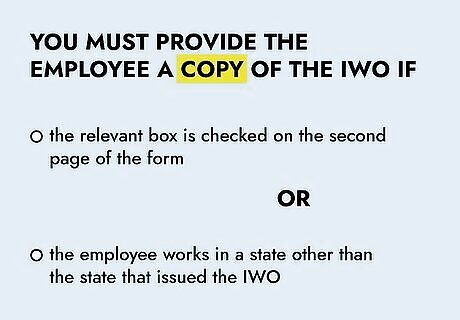
Provide a copy of the IWO to the employee if necessary. Under certain circumstances, you must provide a copy of the IWO to the employee named in the order. If (1) the relevant box is checked on the second page of the form or (2) the employee works in a state other than the state that issued the IWO, you must provide the employee a copy of the IWO.
Calculating Allowable Disposable Income
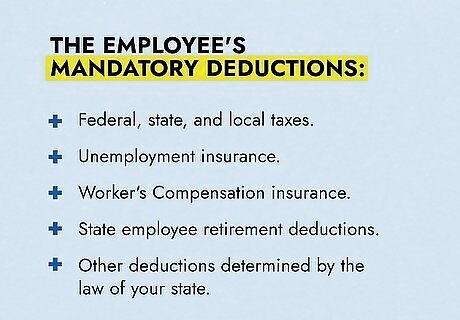
Determine the employee's mandatory deductions. To comply with a valid IWO, you must withhold a portion of the employee's income. To do this, you must first calculate the amount you will withhold for child support. You will start by determining the employee's mandatory deductions. They include: Federal, state, and local taxes. Unemployment insurance. Worker's Compensation insurance. State employee retirement deductions. Other deductions determined by the law of your state (e.g., health-insurance premiums). For example, New York state law requires the following six mandatory deductions: federal income tax, social-security tax, medicare tax, state income tax, city/local income tax, and involuntary retirement/pension-plan payments.
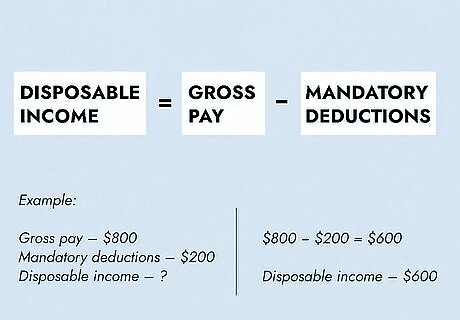
Calculate the employee's disposable income. An employee's disposable income is calculated by subtracting the total amount of mandatory deductions (as determined above) from the employee's gross pay. You will use this amount in calculating the employee's allowable disposable income. Use the following formula to calculate this amount: Disposable Income = Gross Pay – Mandatory Deductions Gross pay includes not only salary, but also other forms of income such as bonuses, commissions, or severance pay. By way of example, let's say that the employee's weekly gross pay is $800, and the amount of mandatory deductions (according to your state's law) is $200. This means that this employee's weekly disposable income is $600 ($800–$200).
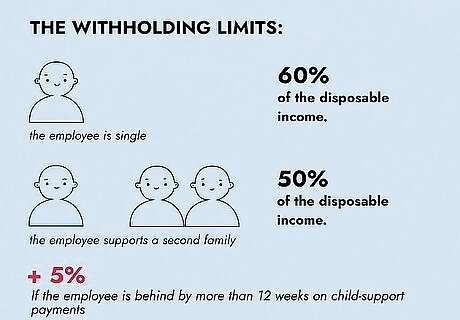
Determine the limit federal/state law places on withholding. The federal Consumer Credit Protection Act places limits on the amount that can be withheld from an employee's disposable income. Using the following federal limits, determine the maximum withholding amount for the employee: If the employee supports a second family, the maximum withholding amount is 50% of the employee's disposable income. If the employee is single, the maximum withholding amount is 60% of the employee's disposable income. If the employee is behind by more than 12 weeks on child-support payments, add an additional 5% to the maximum withholding amount (i.e., 55% for second family, 65% for single). Some states use a percentage more favorable to the employee than the federal law, meaning the maximum withholding amount is less in certain states. Check your state's law to determine the maximum amount you can withhold from the employee's disposable income.

Calculate the employee's allowable disposable income. An employee's allowable disposable income represents the maximum amount that can be withheld from that employee's income for child-support payments. This amount is based on the employee's disposable income and the maximum limit for withholding based on state and federal law. Use the following formula to calculate this amount: Allowable Disposable Income = (Disposable Income) x (the maximum withholding amount expressed as a percentage). Returning to our example, let's say this employee is single, is not behind on child-support payments, and that your state uses the federal maximum-withholding percentages. That means the maximum amount of this employee's weekly income that can be withheld is 60%. So, the allowable disposable income for this employee would be $360 ($600 x .60). This is the maximum amount available for child-support withholding.
Submitting Withheld Income for Child-Support Payments

Determine the date by which you must submit payments. Federal law requires that an employer submit withheld income for child support to the SDU indicated on the IWO within seven business days of withholding the payment. Some states have shorter time limits for submitting this payment. For example, Texas state law requires this payment to be made on the date the employee's income was withheld if submitting by mail, or no later than the second business day after that date if the employer is transferring the funds electronically.

Withhold the appropriate amount for child support. The first page of the IWO lists the amount to be withheld and specifies a time period for that withholding (e.g., $200 per weekly pay period). After you have determined the employee's allowable disposable income for the relevant time period, compare the required child-support payment for that period to the allowable disposable income. If allowable disposable income is greater than the required child support, withhold the full amount of required child support. If allowable disposable income is less than the required child support, withhold the amount of allowable disposable income only. The employee is required to make up the difference by paying the agency that issued the IWO separately to avoid going further into debt. So, let's say our fictional employee owes $300 in weekly child support. Because this employee's allowable disposable income is $360, you would withhold the full amount of child support ($360 > $300). If the weekly child support owed was $400, you would only withhold $360 (because an employee's allowable disposable income is the maximum amount you can withhold).

Submit the withheld wages to the appropriate SDU. After you have withheld a portion of an employee's wages for child support, you must submit these payments to the SDU named in the IWO by the appropriate date, as determined above. Depending on your state, you will have the option of submitting this payment either by mail or electronically. Many states require specific information to be included along with the payment in order to identify it. For example, Kentucky state law requires you to include, for each employee subject to withholding, the employee's name, social-security number, court-assigned case number, specific amount withheld, and the date payment was withheld. Information relating to submission of payments will be included in the IWO, along with the contact information for the relevant SDU.


















Comments
0 comment